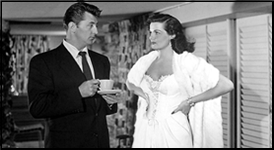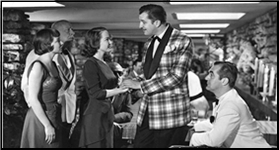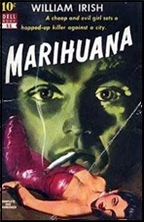FIRST YOU READ, THEN YOU WRITE
by Francis M. Nevins
This month’s column is like the two roads that diverged in a yellow wood. On the first road is a signpost with the initials EQ. On the second, the one less traveled by, there’s another signpost, this one initialed HSK. Any guesses?
In recent years—no, make that recent decades—it seems that I’ve either written or edited or had some connection with the vast majority of books having to do with Ellery Queen, the single exception being BLOOD RELATIONS (Perfect Crime Books, 2012), Joseph Goodrich’s excellent selection from the often acrimonious correspondence between Frederic Dannay (1905-1982) and Manfred B. Lee (1905-1971), the first cousins who used the name Ellery Queen as both their joint byline and their series detective.

Now we have a second exception: Laird R. Blackwell’s FREDERIC DANNAY, ELLERY QUEEN’S MYSTERY MAGAZINE AND THE ART OF THE DETECTIVE SHORT STORY (McFarland, 2019), a title so unwieldy it won’t all fit on the book’s spine, which omits THE ART OF. Blackwell’s aim is to encompass in just 218 pages “the true impact of Ellery Queen on the detective-crime short-story genre.†By Ellery Queen of course he means Fred Dannay, the scholarly-bibliophilic-editorial half of the Queen partnership, who as founding editor of EQMM labored feverishly, beginning at the magazine’s birth late in 1941 and ending not long before his death, both to revive the best short stories of the distant and recent past and to encourage the creation of equally fine stories in the present and future.
Blackwell knows the 40-odd Dannay years of EQMM backward and forward and writes insightfully of the milestone authors and stories that Fred had a hand in developing or preserving. We traverse the entire range of the genre from Poe through Conan Doyle and Chesterton to then newcomers like Stanley Ellin and Edward D. Hoch (who wound up having more than 500 stories published in the magazine) to a few like Jon L. Breen and Josh Pachter and myself who began appearing in EQMM when we were young and Fred was well along in his editorial career and who carry on today like old warhorses continuing, perhaps more gently, to smite the earth.
If I had had a hand in Blackwell’s book I would have nudged him to include the birth and death years of the dozens of authors he covers, giving readers a more vivid sense of the scope and flow of detective-crime fiction in its short form. But I would have fought like a T. rex for the removal of the superabundant typos which pockmark almost every page.
For the benefit of anyone who might think superabundant too strong a word, let’s pick one author totally at random, like the winner of a megabucks lottery, and take a look at what Blackwell has to say about that person. Who won the lottery? Yikes! I did. You’ll find the entry on me at pp. 129-130.
First off, he spells my first name wrong, Frances, the female way, not Francis, the pope’s way, and that of every other man whose name I’ve ever seen written down. Next, he omits my middle initial, as he does with virtually every other author with an initial in his or her byline. Also he gets the titles of two of my early stories wrong. Then he lists as a non-series story one of my earliest EQMM contributions, in fact the first Fred Dannay bought from me, which is not a story at all but a poem (if you want to call it that) in the manner of that great poet (if you want to call him that) Ogden Nash.
Among the other stand-alone stories he credits me with is one (“Black Spider†from the August 1979 EQMM) which features Loren Mensing, also the protagonist of four of my novels and a pile of other EQMM tales. All these flubs in exactly 14 lines of print!
But it’s not as if I’m treated worse than other EQMM contributors. When it comes to having my name misspelled, I stand beside “Jacque†Futrelle (19), “Irving†Cobb (21), “Cornel†Woolrich (22, 90), John “Colliers†(23), Philip “Macdonald†(76), Damon “Runyan†(113), “George†Simenon (128, 189, 216), Ross “MacDonald†(167), and—almost forgot!—that old standby Edgar “Allen†Poe (152).
When it comes to missing middle initials I’m also in excellent company, along with Jon Breen (30, 115, 180), Pearl Buck (101), Charles Child (151), Mignon Eberhart (21), Robert Fish (103, 121, 181) and Edward Hoch (36, 104, 159), just to mention those whose last names begin with the letters A through H. Middle-initialed luminaries like John D. MacDonald and Robert B. Parker would no doubt have endured the same fate had Blackwell mentioned them.
Several authors with three-name bylines, including Dorothy Davis (102, 119) and Earl Biggers (54, 191), get their middle names chopped off. And a number of contributors besides yours truly get story titles messed up, as witness James Yaffe’s “Mr. Kirashubi’s Ashes†(139), Thomas Flanagan’s “The Cold Winds of Adeste†(124, 209), and Conan Doyle’s “The Adventure of the Blue Carbunkle†(45) which will lift every Sherlockian’s eyebrows to the heavens.
More than one protagonist of a stand-alone story, like Kachoudas (or, as Blackwell calls him, Kouchadas) in Simenon’s prize-winning “Blessed Are the Meek,†is listed as a series character. Even book titles mentioned in passing are mangled; notice, for example, Blackwell’s version of the Bill Pronzini-Marcia Muller nonfiction anthology 101 MIDNIGHTS, which dumps a whopping 900 witching hours down the memory hole.
A number of significant dates are also off, for example the death of Ed Hoch, which occurred in 2008 not 2018. (If only Ed had enjoyed the extra ten years of life with which Blackwell gifts him!)
But now comes the weird part. Those 14 scrambled lines about me are followed by three paragraphs of text which demonstrate that Blackwell is both knowledgeable and insightful about the stories I wrote for EQMM back in the Seventies and early Eighties when Fred Dannay was still alive and editing. This strange dichotomy, that the material in coherent sentences is of a much higher order than what is found in the lists, persists throughout Blackwell’s 218 pages.
It’s almost as if he had completed the part of the book that consists of sentences and then turned the list-making function over to an ignoramus. The sentences contain very few factual flubs (the main one I caught being that Erle Stanley Gardner’s scam-artist character Lester Leith is identified on page 71 as a criminal lawyer) and plenty of keen observations. All the gaffes I’ve highlighted don’t seriously detract from what Blackwell has accomplished here. If you can turn a blind eye to everything but the good parts, you can learn much from this book.
Now let’s move away from serious stuff and spend a few minutes with the great wackadoodle of detective-crime fiction.
In the late 1950s the Chicago branch of Mystery Writers of America was a small and sleepy organization, among whose members was our revered filbert Harry Stephen Keeler (1890-1967). Even though no American publisher had bought a book from him since 1948 and his English publisher had dropped him five years later, Keeler kept up his membership—mainly because it gave him access to just about the only social life he had—and kept hoping his luck would change.

His closest friend among the members was W.T. Brannon (1906-1981), an eyepoppingly prolific author of true-crime pieces for magazines. The members he seemed to envy most deeply were Richard Himmel (1920-2000) and Milton K. Ozaki (1913-1989), who had managed to hitch rides on that gravy train of 1950s popular fiction, the original paperback novel.
Keeler was no more equipped to write for that market than is a toad to perform a Louis Vierne organ symphony, but every so often he’d make a half-hearted stab in that direction. THE AFFAIR OF THE BOTTLED DEUCE (Ramble House, 2009).seems to have started out as one of those stabs.
This 65,000-word novel, completed on August 15, 1958, was immediately followed by THE STRAW HAT MURDERS, which I discussed in this column a few months ago, and THE CASE OF THE TRANSPARENT NUDE, which I may take up later this year. What makes all three rarae aves in the Keeler Kanon is that they might pass in a pea-soup fog for the kinds of softcover originals about tough cops tackling crime in the big city’s mean streets that were being published regularly by Gold Medal, Ace, Avon, Dell, Pyramid and countless other houses of the time.
Pull down Fender Tucker’s A TO IZZARD: A HARRY STEPHEN KEELER COMPANION (Ramble House, 2002), turn to the collection of opening paragraphs from Harry’s novels in the bibliography at the end of this matchless tome, and compare the first lines of BOTTLED DEUCE with those of every other novel he wrote during the year or so before and after. See the difference?
Police Captain Michael Simko, day-chief of Chicago Avenue Police Station, raised the telephone on his battered desk as it rang raucously.
“Chicago Avenue Police Station,†he said wearily.
One might almost believe Harry thought that if he aped the pb-original manner for a few pages, some editor would send him a contract and advance without bothering to read further! It didn’t work, of course. BOTTLED DEUCE was published nowhere—not in the U.S., not in England, not even in Spain where a number of his Fifties novels had been appearing as originals—until the Ramble House edition which came out early in 2005.

Among the paperback thriller specialists of the Eisenhower years were some first-rate talents: David Goodis, Jim Thompson, Day Keene, Harry Whittington, John D. MacDonald, Jonathan Craig and Ed McBain, just to name seven. If what you want is not what these guys offered but the unreconstructed nut that was our Harry, fear not. BOTTLED DEUCE begins as he introduces us to his versions of pb-original Homicide cops: Louis TenEyck Ousley, skinny and wart-faced and called Lousy Lou by all and sundry—a nice role for Dan Duryea if by some miracle the movie rights in this then unpublished and by sane standards unpublishable book had been sold back in the Fifties!—and Homer “Butterball†Tomaroy, who resembles a human dumpling and would have been a perfect part for Lou Costello.
Then Harry quickly forgets what he started out to accomplish and the train of plot switches onto the tracks we know and love. Lythgoe Crockett, a naive and paranoid young man living in a dump in Chicago’s Little Italy while trying to write the Great American Novel—his costume while in the throes of composition being bathing trunks and grass slippers!—apparently shot himself in the head in his apartment, all of whose doors and windows are locked from the inside, shortly after receiving a package containing a deuce of diamonds in a bottle. What could have motived and motivated such an act?
Then when Lousy Lou discovers that the gun dangling from Crockett’s nerveless hand is made of wax, the question morphs into: Why would anyone commit murder in such a cockamamie way, and how could both murderer and weapon have vanished from Crockett’s sealed apartment? In time the answers seem to emerge, and Rilla Kenshaw, girl magician, finds herself in jail and indicted for the crime by sadistic State’s Attorney Herman Kober, her only hope being the lone-wolf investigation of Lousy Lou, with sympathetic nods from Assistant State’s Attorney Chalfont Nortell.
Eventually Harry allows himself to vent some pet peeves, notably the sex-obsessed nature of current best-sellers like PHAETON PLACE and—talk about biting the hand he hoped would feed him!—of the novels published as 25-cent paperback originals. The case climaxes with a reconstruction of events in Crockett’s apartment, presided over by Lousy Lou but dominated by Sheridan Overturf, a bottom-rung magazine publisher whose like Harry had dealt with and worked for in his salad days as an editor.
If you’re familiar with the milestones of detective fiction, you won’t long wonder why in the late chapters Harry introduces—in his own inimitable way, by having other characters talk about him!—one Jamrock James, a.k.a. Old Sherlock Holmes the II’d. Any Sherlockian who gives the matter some thorght should be able to anticipate the ultimate gimmick in this book, although the trappings are a million times zanier than Conan Doyle’s.
BOTTLED DEUCE isn’t in the same league with the Keeler Klassics of the Eisenhower era like THE STREET OF A THOUSAND EYES and THE RIDDLE OF THE WOODEN PARRAKEET, but it’s wackily satisfying in its own terms and all true Harryphiles huzzahed loudly when it finally became available. So might you if you care—or should I say dare?—to check it out.
—
Editor’s Note: Thanks to graphic designer-artist Gavin L. O’Keefe for providing me with both front and back cover images for the Keeler book, done most stylistically in the 1940s Dell mapback mode.




















